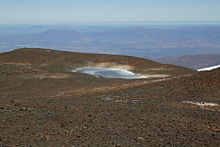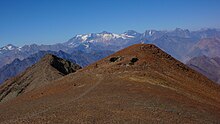


The Plomo Mummy (also known as Boy of El Plomo, El Plomo Mummy, or La Momia del Cerro El Plomo in Spanish) is the well preserved remains of an Incan child found on Cerro El Plomo near Santiago, Chile in 1954.[1][2] It was discovered by Guillermo Chacón Carrasco, Jaime Ríos Abarca, and Luis Gerardo Ríos Barrueto.[3] The mummy was brought to the attention of Grete Mostny at the Chilean National Museum of Natural History; she later proved instrumental in the museum's acquisition of the specimen.[4] The Plomo Mummy was the first notable frozen mummy discovery of high-altitude human sacrifice by the Incas,[5][6] a practice called qhapaq hucha.
The mummy is curated by the National Museum of Natural History in Santiago, Chile, where a replica of the mummy is on public display. In 2003, histological examinations of the remains revealed the presence of a primitive species of the Trichinella parasite.
Burial edit
The El Plomo mummy was excellently preserved due to high altitude and low humidity conditions. It was located in a 1 meter deep pit, covered with a capstone in one of several small stone structures. The child was in a sitting position, hugging his knees. The reason for this boy's death was for ritual child sacrifice, the cause of death is uncertain, but is likely due to suffocation after being buried alive. Vomit stains were found around the boy's lips and on his clothing. A possible explanation for this is that he being given maize beer and coca to induce numbing effects for the sacrifice[7][8].
The body was fully clothed, most of the articles of clothing were made from alpaca or llama wool. His garb consisted of a black sleeveless tunic, a large grey shawl, a headdress decorated with condor feathers. There were unused leather moccasins on his feet and a headband was used to keep his hair in place. He was also wearing two pieces of silver jewelry, a heavy bracelet and an H-shaped pendant, both of which indicates a high or elite social status[7][8].
Buried along with the body were several grave goods. These include several figurines, a silver female idol dressed in miniature clothes, a llama covered in gold, and another llama made from a red shell. A small woven bag contained coca leaves which still produced a fragrance. Finally, several balls made from animal intestines contained human hair, fingernail clippings, and teeth[7][8]. Along with the sacrifice of the child himself, these objects are used to appease the mountain deities to stop disastrous natural events, promote good weather and fertility, or for other religious events[9].
My references:
Ceruti, Constanza. "Human bodies as objects of dedication at Inca mountain shrines (north-western Argentina)." World Archaeology 36.1 (2004): 103-122.
Horne, Patrick D. "The Prince of El Plomo: a frozen treasure." Human Mummies. Springer, Vienna, 1996. 153-157.
Horne, P. D., and S. Quevedo Kawasaki. "The Prince of El Plomo: a paleopathological study." Bulletin of the New York Academy of Medicine 60.9 (1984): 925.
References edit
- ^ Horne, P. D.; Kawasaki, S. Q. (1984). "The Prince of El Plomo: A paleopathological study". Bulletin of the New York Academy of Medicine. 60 (9): 925–31. PMC 1911799. PMID 6391593.
- ^ Tierney, Patrick (1990). The highest altar: unveiling the mystery of human sacrifice. New York, N.Y., U.S.A.: Penguin Books. ISBN 978-0140139747.[page needed]
- ^ Fuenzalida, Humberto (1959). "Historia del hallazgo" (PDF). Boletin Del Museo Nacional de Historia Natural. XXVII: 4.
- ^ Mouat, Francisco (September 2014). "Breve Biografía de la Doctora Grete Mostny (1914 -1991)" (PDF). Museo Nacional de Historia Natural Chile. Retrieved November 8, 2017.
- ^ Ceruti, Maria Constanza (2015). "Frozen Mummies from Andean Mountaintop Shrines: Bioarchaeology and Ethnohistory of Inca Human Sacrifice". BioMed Research International. 2015: 439428. doi:10.1155/2015/439428. PMC 4543117. PMID 26345378.
{{cite journal}}: CS1 maint: unflagged free DOI (link) - ^ Clark, Liesl (November 24, 1998). "Ice Mummies of the Inca". pbs.org. Retrieved 24 July 2012.
- ^ a b c Horne, Patrick D. "The Prince of El Plomo: a frozen treasure." Human Mummies. Springer, Vienna, 1996. 153-157.
- ^ a b c Horne, P. D., and S. Quevedo Kawasaki. "The Prince of El Plomo: a paleopathological study." Bulletin of the New York Academy of Medicine 60.9 (1984): 925.
- ^ Ceruti, Constanza (2004). "Human Bodies as Objects of Dedication at Inca Mountain Shrines (North-Western Argentina)". World Archaeology. 36 (1): 103–122. ISSN 0043-8243.